Marc Heinrich
The ATLAS of Traffic Lights: A Reliable Perception Framework for Autonomous Driving
Apr 28, 2025



Abstract:Traffic light perception is an essential component of the camera-based perception system for autonomous vehicles, enabling accurate detection and interpretation of traffic lights to ensure safe navigation through complex urban environments. In this work, we propose a modularized perception framework that integrates state-of-the-art detection models with a novel real-time association and decision framework, enabling seamless deployment into an autonomous driving stack. To address the limitations of existing public datasets, we introduce the ATLAS dataset, which provides comprehensive annotations of traffic light states and pictograms across diverse environmental conditions and camera setups. This dataset is publicly available at https://url.fzi.de/ATLAS. We train and evaluate several state-of-the-art traffic light detection architectures on ATLAS, demonstrating significant performance improvements in both accuracy and robustness. Finally, we evaluate the framework in real-world scenarios by deploying it in an autonomous vehicle to make decisions at traffic light-controlled intersections, highlighting its reliability and effectiveness for real-time operation.
A Chefs KISS -- Utilizing semantic information in both ICP and SLAM framework
Apr 02, 2025Abstract:For utilizing autonomous vehicle in urban areas a reliable localization is needed. Especially when HD maps are used, a precise and repeatable method has to be chosen. Therefore accurate map generation but also re-localization against these maps is necessary. Due to best 3D reconstruction of the surrounding, LiDAR has become a reliable modality for localization. The latest LiDAR odometry estimation are based on iterative closest point (ICP) approaches, namely KISS-ICP and SAGE-ICP. We extend the capabilities of KISS-ICP by incorporating semantic information into the point alignment process using a generalizable approach with minimal parameter tuning. This enhancement allows us to surpass KISS-ICP in terms of absolute trajectory error (ATE), the primary metric for map accuracy. Additionally, we improve the Cartographer mapping framework to handle semantic information. Cartographer facilitates loop closure detection over larger areas, mitigating odometry drift and further enhancing ATE accuracy. By integrating semantic information into the mapping process, we enable the filtering of specific classes, such as parked vehicles, from the resulting map. This filtering improves relocalization quality by addressing temporal changes, such as vehicles being moved.
Modular Fault Diagnosis Framework for Complex Autonomous Driving Systems
Nov 14, 2024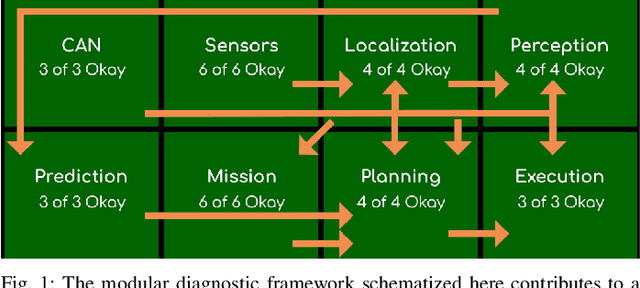
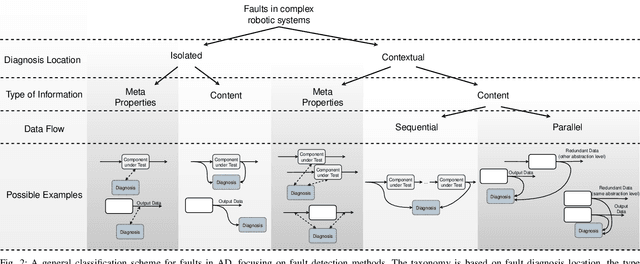
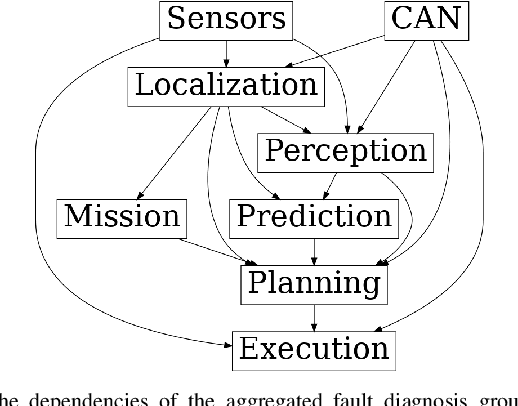
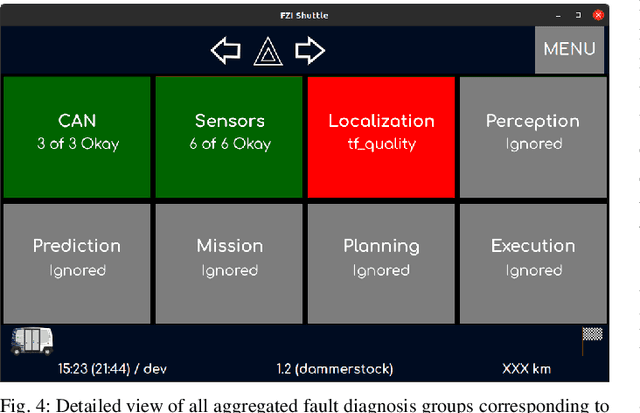
Abstract:Fault diagnosis is crucial for complex autonomous mobile systems, especially for modern-day autonomous driving (AD). Different actors, numerous use cases, and complex heterogeneous components motivate a fault diagnosis of the system and overall system integrity. AD systems are composed of many heterogeneous components, each with different functionality and possibly using a different algorithm (e.g., rule-based vs. AI components). In addition, these components are subject to the vehicle's driving state and are highly dependent. This paper, therefore, faces this problem by presenting the concept of a modular fault diagnosis framework for AD systems. The concept suggests modular state monitoring and diagnosis elements, together with a state- and dependency-aware aggregation method. Our proposed classification scheme allows for the categorization of the fault diagnosis modules. The concept is implemented on AD shuttle buses and evaluated to demonstrate its capabilities.
CoCar NextGen: a Multi-Purpose Platform for Connected Autonomous Driving Research
Apr 26, 2024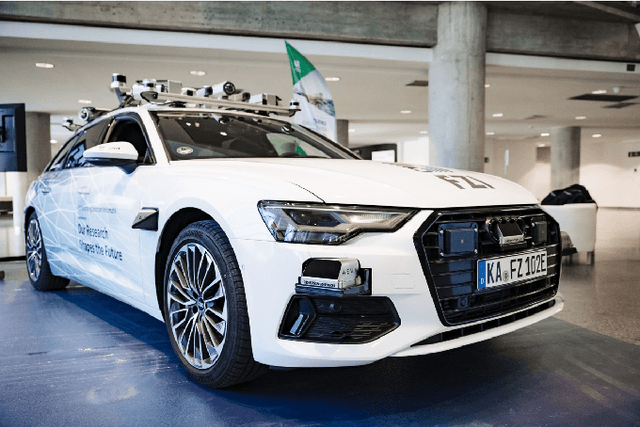



Abstract:Real world testing is of vital importance to the success of automated driving. While many players in the business design purpose build testing vehicles, we designed and build a modular platform that offers high flexibility for any kind of scenario. CoCar NextGen is equipped with next generation hardware that addresses all future use cases. Its extensive, redundant sensor setup allows to develop cross-domain data driven approaches that manage the transfer to other sensor setups. Together with the possibility of being deployed on public roads, this creates a unique research platform that supports the road to automated driving on SAE Level 5.
One Stack to Rule them All: To Drive Automated Vehicles, and Reach for the 4th level
Apr 03, 2024



Abstract:Most automated driving functions are designed for a specific task or vehicle. Most often, the underlying architecture is fixed to specific algorithms to increase performance. Therefore, it is not possible to deploy new modules and algorithms easily. In this paper, we present our automated driving stack which combines both scalability and adaptability. Due to the modular design, our stack allows for a fast integration and testing of novel and state-of-the-art research approaches. Furthermore, it is flexible to be used for our different testing vehicles, including modified EasyMile EZ10 shuttles and different passenger cars. These vehicles differ in multiple ways, e.g. sensor setups, control systems, maximum speed, or steering angle limitations. Finally, our stack is deployed in real world environments, including passenger transport in urban areas. Our stack includes all components needed for operating an autonomous vehicle, including localization, perception, planning, controller, and additional safety modules. Our stack is developed, tested, and evaluated in real world traffic in multiple test sites, including the Test Area Autonomous Driving Baden-W\"urttemberg.
Leveraging Swarm Intelligence to Drive Autonomously: A Particle Swarm Optimization based Approach to Motion Planning
Apr 03, 2024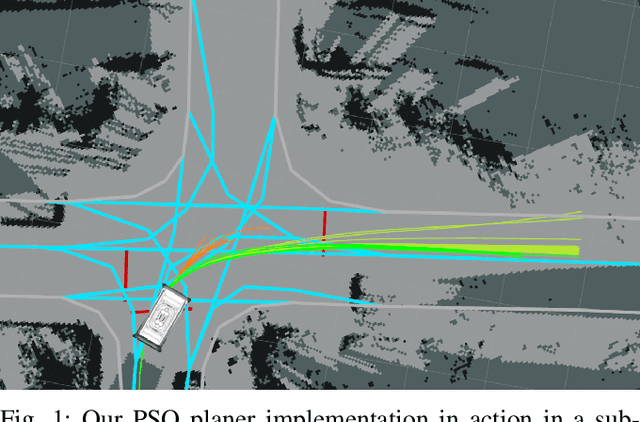
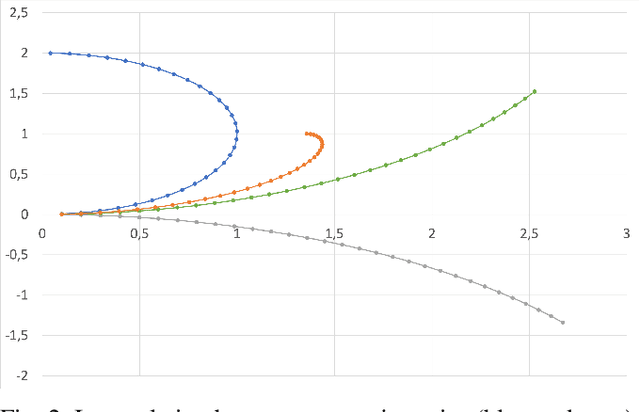
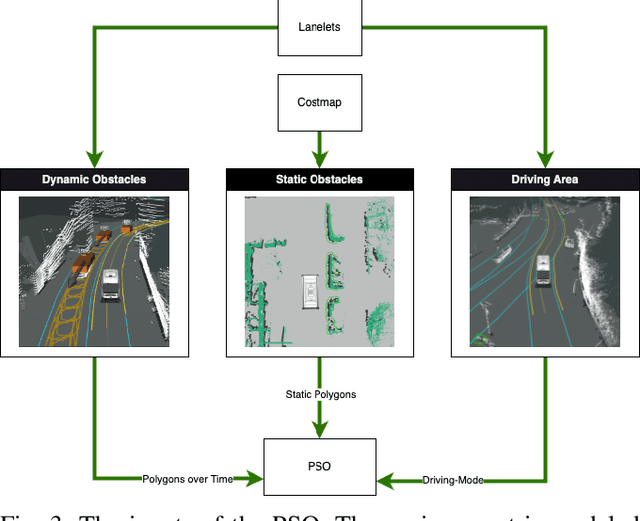

Abstract:Motion planning is an essential part of autonomous mobile platforms. A good pipeline should be modular enough to handle different vehicles, environments, and perception modules. The planning process has to cope with all the different modalities and has to have a modular and flexible design. But most importantly, it has to be safe and robust. In this paper, we want to present our motion planning pipeline with particle swarm optimization (PSO) at its core. This solution is independent of the vehicle type and has a clear and simple-to-implement interface for perception modules. Moreover, the approach stands out for being easily adaptable to new scenarios. Parallel calculation allows for fast planning cycles. Following the principles of PSO, the trajectory planer first generates a swarm of initial trajectories that are optimized afterward. We present the underlying control space and inner workings. Finally, the application to real-world automated driving is shown in the evaluation with a deeper look at the modeling of the cost function. The approach is used in our automated shuttles that have already driven more than 3.500 km safely and entirely autonomously in sub-urban everyday traffic.
An Application of Scenario Exploration to Find New Scenarios for the Development and Testing of Automated Driving Systems in Urban Scenarios
May 17, 2022



Abstract:Verification and validation are major challenges for developing automated driving systems. A concept that gets more and more recognized for testing in automated driving is scenario-based testing. However, it introduces the problem of what scenarios are relevant for testing and which are not. This work aims to find relevant, interesting, or critical parameter sets within logical scenarios by utilizing Bayes optimization and Gaussian processes. The parameter optimization is done by comparing and evaluating six different metrics in two urban intersection scenarios. Finally, a list of ideas this work leads to and should be investigated further is presented.
New Algorithmic Approaches to Point Constellation Recognition
Mar 24, 2014



Abstract:Point constellation recognition is a common problem with many pattern matching applications. Whilst useful in many contexts, this work is mainly motivated by fingerprint matching. Fingerprints are traditionally modelled as constellations of oriented points called minutiae. The fingerprint verifier's task consists in comparing two point constellations. The compared constellations may differ by rotation and translation or by much more involved transforms such as distortion or occlusion. This paper presents three new constellation matching algorithms. The first two methods generalize an algorithm by Bringer and Despiegel. Our third proposal creates a very interesting analogy between mechanical system simulation and the constellation recognition problem.
 Add to Chrome
Add to Chrome Add to Firefox
Add to Firefox Add to Edge
Add to Edge